
Health 'Insurance' at Sea: 1 2 3 4 5 6 7 8 9 10 11 12 13 Next>>
Health 'Insurance' at Sea During the Golden Age of Piracy, Page 5
Intermediate Health Care - Navy: Landed Hurt and Sick
"When the Sailers are put Sick, ashore, they are provided for by Officers appointed at the several Ports by the Commissioners for Sick and Wounded, whose Business it is to take care not only for their Lodgment and Nurses, but also for all other Things necessary for the Cure of their Wounds, and Diseases." (Josiah Burchett, "To the Reader", Memoirs of Transactions at Sea During the War with France, 1703, not paginated)
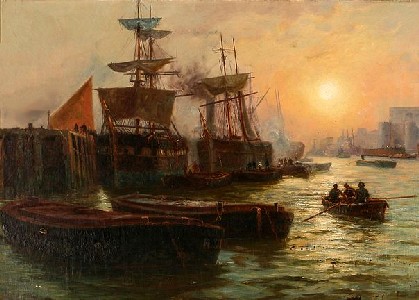
Artist: Charles John De Lacy (19th century)
Once the hurt and sick navy men were brought ashore it was the Sick and Hurt Commission's job to see that they were housed for the duration of healing.1 Such housing could be provided in a variety of ways. The least preferred measure was temporary shelter, which included tents where necessary or port-based buildings meant for transitory lodging until the men could be diagnosed and sent on to other sites for care. A preferred shelter was to quarter wounded and ill sailors in private boarding houses, although this was an expensive option for the government. Even better in the eyes of the Navy was lodging of patients in hospitals - local port hospitals when possible, but preferably London hospitals. Although this was favorable to the Naval Board, it was not to the hospitals. This eventually led to the Navy building its own hospital which started taking patients in 1705. This provided them with the best option for sick and wounded sailors, particularly those requiring more extended care. The navy also established some foreign hospitals for use when they were convenient to the war being fought. This section looks at each of these options.
1 John J. Keevil, Medicine and the Navy 1200-1900: Volume II – 1640-1714, p. 7
Intermediate Health Care - Navy: Landed Hurt and Sick Temporary Lodging
While they were the least preferable option, temporary lodgings were used by the English navy leading up to and during the golden age of piracy. The navy generally didn't rely on shore-based tent sites as the merchants and privateers did. Sometimes it was the most expedient option, however. A surgeon with the fleet at Tor Bay (Devon) advised Admiral Lord John Berkeley "'to have Tents made ashore for the Men that were most afflicted with that Distemper' [scurvy]. Above a hundred were landed and 'had fresh Provisions allowed them, with Carrots, Turnips and other green Trade'"1
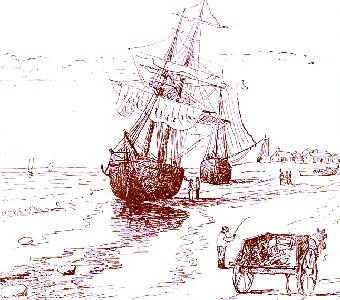
Artist: Samuel Adams Drake (1891)
Some sick and hurt men were in tents on shore in England in 1693 when it wasn't possible to find other lodging for them.2 However, tents seem to have been a shelter of last resort for the navy.
When tents were not used, other temporary shelter had to be arranged for the sick and wounded men landed in England's ports until more permanent residence could be arranged. As the navy was preparing for the First Dutch War in 1652, the Admiralty Committee requested temporary naval sick quarters, requesting "a convenient house at Deal should be rented and used as a hospital for naval wounded, 'with a surgeon and all other necessaries as shall be advised by the Corporation of Surgeons' Hall'."3 In addition to hospitals being reserved for the wounded and ill, "other accommodation was to be the responsibility of the port authorities"4, which may have included temporary lodgings in some of the ports.
When England's Privy Council began preparing for the war in 1689, they "recognized that in the absence of large hospitals on the coast or at any of [the] ports, except Plymouth, a transitional period in lodgings might be unavoidable, and therefore they authorized the provision at these centres of a 'Physician if need be & Chyrurgion & Nurses, Fire, Candle, Linnen, Medicaments, and all other things Necessary'."5 As the preparations went on, these 'transitional' lodgings become temporary hospitals, set up for the duration of the war. They will be discussed in greater detail in the section on Navy Hospitals for the Landed Sick and Hurt.
However, such temporary facilities were not preferred and as the war went on and the difficulty of finding lodging for sick and invalid sailors increased, interest was renewed in opening a more permenant naval health care facility.
1John J. Keevil, Medicine and the Navy 1200-1900: Volume II – 1640-1714, p. 276; 2 Keevil, p. 191; 3,4 Keevil, p. 6; 5 J.R. Tanner, Samuel Pepys and the Royal Navy, 1920, p. 49
Intermediate Health Care - Navy: Private Lodging of the Landed Hurt and Sick
"To preserve those who yet continued in Health, we separated the Ship entirely to their Use, and moved the Sick on Shore to the best Houses and Conveniences that could be hired...." (Sea Surgeon John Atkins, The Navy Surgeon, 1742, p. 359)
Another method of quartering the landed sick and wounded was to lodge them in local homes, lodging-houses and even alehouses. The accommodation of wounded soldiers in private
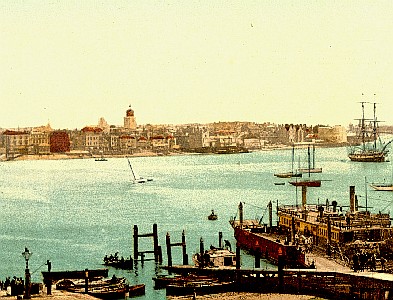
Photo: Detroit Publishing Company
Portsmouth Harbor as Seen From Gosport
(19th century)
lodging-houses located in coastal towns managed by landladies dates to the 1620s. Here the men were to be ministered by local physicians and surgeons.1
Historian Kathleen Harland explains, "when the quartering system was working at its best, many illnesses and wounds were capable of resolution by simple nursing in a clean, dry house wehre propera attention was given to diet and medication."2
Quartering was continued under all five of the Hurt and Sick Commissions during periods of war, although its use diminished over time. Three factors led to the reduced reliance on private lodgings: quality, cost, and resistance.
The quality of care at a private dwelling varied greatly. Each area had different physicians and surgeons tending the wounded, resulting in wide variances in how the men were tended to. The Commissioners of either the Navy or the Sick and Hurt, most of whom had little or no medical background, were tasked with finding surgeons to tend the men in local housing at the ports. (The exception was the fifth Commission which notably contained two medical doctors - Charles Morley and Richard Adams3.) A Navy Commissioner at Dover in 1653 was faced with 55 men who were wounded with grape shot [a type of cannon shot which broke apart into shrapnel after being fired), so he "obtained within a few hours the services of some physicians and surgeons who visited and dressed them in various lodgings, since there was no hospital; many amputations had had to be performed"4.
In addition, the attention and ministrations of each landlady would be different and difficult to monitor. The Navy received some complaints that sailors "lye dispersed under cure in lewd ale-houses"5 where the focus may have been more on selling them drink than healing.
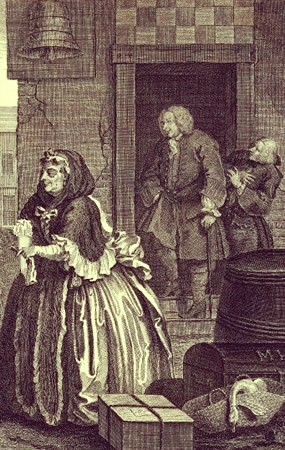
Artist: William Hogarth (1731)
In 1653, physician Daniel Whistler wrote that he found "in relation to the general care of sick and wounded men [in Portsmouth, there is] so great a difficulty of right accommodating them with means suitable for their safe and speedy recovery in respect of their scattered quarters... [there is a lack] of linen and medicines timely which should be in readiness aforehand in store... Besides [there is] the difficulty and change otherwise of ordering their diet, nursing: the thronging of weak men into poor stifling houses, who have no other [choice] but strong drinks"6.
The cost of lodging men at private dwellings was another important consideration for the Navy Commission. Where landladies were given a shilling a day to care for each ill and hurt sailor, "the London hospitals of St. Bartholomew's and St. Thomas's had, since 1646, received a payment of two shillings a week for each service patient they treated, which was half the cost for such treatment in provincial hospitals and less than a third of the charge in private lodgings."7
It was for this reason during the first Dutch War that Major Bourne, Navy Commissioner at Harwich, "was directed to evacuate all permanently disabled men to London in order to reduce the strain on accommodation and on finances"8. In preparation for William's War in 1689, it was ordered that private houses could be used to house sailors "[o]nly if no hospital beds were available."9 Historian John Keevil notes, "Following a battle, or during an epidemic, billeting could not be avoided, and the standard payments were made even when a wounded man was nursed in his own home by his wife, but every effort was made to transfer cases to the cheaper accommodation in hospitals whenever beds were available."10
The last reason for preferring hospitals to private lodging was resistance from the people offering the lodging. This stemmed from two problems: slow payment by the navy for quartering sick and wounded men and the amount offered to a private dwelling for these men.
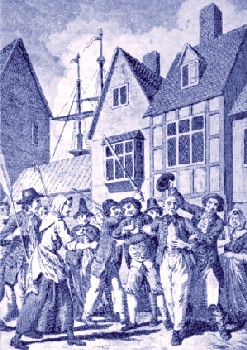
Image: Male Grignion
From: The Capture of Judge Jeffreys, from
The
British Tar in Fact and Fiction, p. 18 (1688)
As early as 1653, townspeople and villagers were complaining about the government's failure to pay them.11 Their complaints seemed to have little effect on slow payments, however. In 1690 the Sick and Hurt Commission "found that, among others, the lodging-house keepers of Portsmouth refused to take in sick seamen on the grounds of non-payment in the past"12. This distrust continued in 1694 when "instances of landladies refusing to accept any more patients unless they received an advance payment"13.
Added to this problem of payment was the fact that the navy pay was considered by many lodging-house keepers to be inadequate. In 1653, the Mayor of Dover reported that "he would have great difficulty in persuading his townspeople to open their doors for so small a sum as a shilling a day."14 The Privy Council ignored these complaints, continuing to allow a shilling per day for men being housed privately in 1690 "forgetting the lodging-house doors closed to the wounded in the past, [and] disregarding the rise in the cost of living since the days of the Commonwealth [1649~1660]"15.
Of course, not everyone felt this way. At the beginning of the Second Dutch War, when Surgeon-General James Pearse decided to rely more on the hospitals than private dwellings for the hurt and ill, the port communities were concerned. Some even took action to protect their interests:
On September 11, 1672, Balthazar St. Michel, Deputy Commissioner for Sick and Wounded at Deal voiced popular feeling when he wrote to [Samuel] Pepys, asking him to persuade Pearse to favour Deal by 'sending Sick and woonded men Heare'; he enlarged on the good care they had always received, the few patients remaining in the port he having discharged all those cured to their ships and how the town would welcome more "where our cleanly nurses houses are redy now to reseave them'.16
1 Dr. Kathleen Harland, "Naval Medical Care 1620-1770 Saving the Seamen: Naval medical care in the Pre-Nelson era, 1620-1770," J Royal Medical Service 2005, p. 64; 2 Harland, p. 71; 3 John J. Keevil, Medicine and the Navy 1200-1900: Volume II – 1640-1714, p. 235; 4 Keevil, p. 12; 5 Keevil, p. 195; 6 Keevil, p. 14; 6,7 Keevil, p. 19; 8 Keevil, p. 14; 10 Keevil, p. 127; 12 Keevil, p. 52; 13 Keevil, p. 174; 14 Keevil, p. 198-9; 15 Keevil, p. 16; 15 Keevil, p. 191; 16 Keevil, p. 127
Intermediate Health Care - Navy: Landed Hurt and Sick Hospital Lodging
In preparation for William's War, orders issued in 1689 to the fourth Sick and Hurt Commission asking them to determine how many men the hospitals in England could accommodate. Sailors were to be sent to the most convenient hospital "Immediately after being sett on shoar"1.
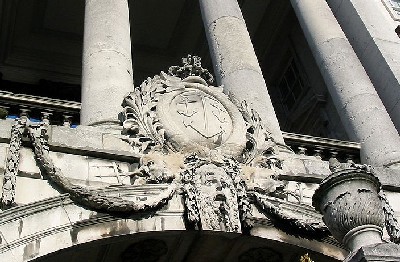
Photo: Wikimedia User Man vyi -Badge of the Navy Board on Somerset House
Public and military hospitals were the navy's intermediate health care lodging of choice for ill and wounded sailors until the first naval hospital opened in 1705. Samuel Pepys "favoured the use of hospitals and almshouses when vacancies arose which could be interpreted as in the king's gift. [King] Charles agreed that the maimed must be given preferential treatment, and that all such vacancies should be notified to the Admiralty."2
Initially it was hoped that hospitals located near the ports where the sailors were landed could be used. It was with this desire that the Admiralty Committee requested that magistrates in the chief ports reserve a portion of the hospital beds in their area for "the sick and wounded seamen and marines... when they are put on shore" in preparation for the first Dutch War in 1652. However, "port officials were soon to reveal that there were no hospitals to commandeer on the coast."3 The Committee had a house rented in Deal so that a temporary hospital could be set up as explained in the previous section. They further requested that "the moiety [half] of all hospitals in England be reserved for such as shall be wounded in the service of the navy, as they shall become void, from and after the 1st of January next [1653]"4. The responsibility for arranging the use of smaller local hospitals appears to have fallen to the local area Commissioners of the Sick and Hurt.
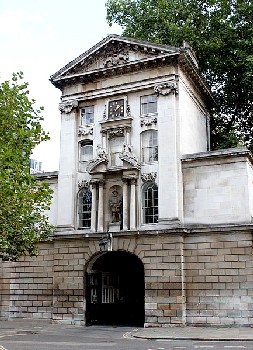
Image: Wiki User DBaK
Henry VIII Entrance to St Bart's, Opened 1702
This 'nationalization' of parts of civil hospitals was to be repeated as each new war began. In preparation for the Second Dutch War, the Privy Council "wrote to the governors of St. Bartholomew's [a hospital located in Smithfield, London] and St. Thomas's [a hospital located in Southwark, London during this period], warning them not to admit new civilian patients", sending a Commissioner to deliver the Council's order that they reserve half their beds for the wounded5. Similar orders were given in 1672 to St. Thomas's and St. Bartholomew's as well as provincial hospitals to ready them for patients from the upcoming Third Dutch War6. This occurred again for William's War in 1678, when St. Bartholomew's and St. Thomas's were to be ready to receive "all such sick and wounded souldiers as shalbe directed unto you"7.
In preparation for the Second Dutch War in 1664, St. Bartholomew's governors "arranged for six wards to be prepared with accommodation for ninety-one single-bed patients, while St. Thomas's officers ordered ‘that one hundred and twenty beds be speedily made ready for such reception’"8. Yet even this was not adequate because the wounded soldiers often exceeded the available capacity of the hospitals. Following the Battle of Texel on August 21, 1673 all of the beds available in hospitals and houses for naval patients from the White and Red Squadrons were filled leaving no place to put some of the wounded men. The "wounded were still arriving in September as beds became vacant, and [St. Thomas's] hospital was never without a large number of naval patients until late in 1674."9
While St. Bart's and St. Thomas's were public hospitals, treating all types of cases, two other hospitals existed - the Savoy and Ely House - which were opened as military hospitals as needed. 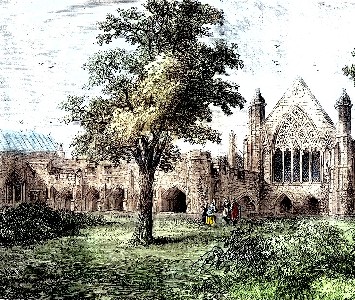
Artist: William Henry Prior
/Ely House and St. Ethedredas Chapel in 1772
The Savoy Hospital was originally established for the poor and needy by Henry VII in 1512, but was converted into a military hospital in 1642. Being run primarily by surgeons, it focused on surgical cases.10 When it wasn't being used for military purposes, it returned to "return to its proper use for the benefit of the poor"11. Ely House was originally a palace belonging to the Bishops of Ely who transferred it to the Commissioners for Sick and Maimed Soldiers to be used as a military hospital in 1648.12 The physicians held sway at the Ely House, so it focused less on surgical and more on medical cases "including infective, systemic, and psychiatric disorders."13
Each of these two hospitals initially had accommodations for about 100 men.14 The board of the Sick and Hurt Commission took charge of Ely House in 1654, resulting in "much rebuilding and refurnishing; new wards [being] opened... [although] additions to Ely House were not fully open before the Dutch War ended, but were of great use in the succeeding Spanish War"15.
Like the Sick and Hurt Commissions, the two military hospitals were intended to be closed after a war ended. However, this wasn't always possible because of the number of chronic cases among the soldiers and sailors. After the First Dutch War the "Savoy and Ely House had to be retained for the services long after the fighting ended [in 1654]"16, with the last 140 patients from the war being sent home in late 1660 so that both hospitals could be closed.17 The Savoy was reopened for military use for both the second and third Dutch Wars, but neither it nor the Ely House were used again as military hospitals after that.18
Historian John Keevil paints a vivid picture of treatment for wounded sailors brought to the Savoy Hospital in London during the first Dutch War.
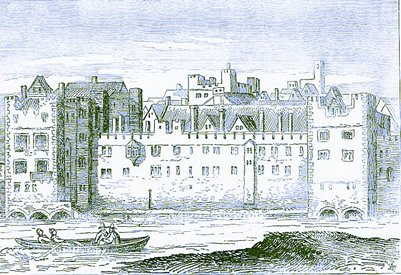
Artist: Wenceslaus Hollar - Savoy Palace Hospital in 1650 (1874)
The wounded seamen, brought from the coast to the Savoy by an escort of four, immediately recognized the familiar smell of burning pitch with which the hospital was fumigated. He found himself carried through a hall to one of four wards, Long, Chapel, Newbury or Reading, and placed on a wooden frame bed, whose cord lacing was covered with a feather tick and bolster, sheets of unbleached linen hemmed and marked by the nurses, blankets, and a woollen coverlet. In the winter, the beds were prepared with a warming pan; bed cases were supplied with a pewter chamber-pot and bed stool and a supply of tow. The ward windows were curtained, and screens were available. Dangerous cases had a night watch, the nurse sitting beside a candle held in a tin or brass candlestick.…
If, as in most cases, the patient had had an amputation, he was given a bed-cradle [for his limb] made by the carpenter. His wound was dressed with cotton dyed red, and bandaged with a linen roller made from surplices confiscated from the City churches and frequently laundered. When he got up, he was supplied with long crutches, locally made, and later with an iron or wooden leg fitted with straps; while exercising on this he used short crutches. Fracture cases were treated in home-made wooden splints; straw trusses were provided for hernia patients.19
Keevil notes that patients who got into fights and arguments, gambled, or stayed up 'unseasonably at Night' were kicked out of the military hospitals. However they were not immediately punished for drinking unless 'certified' by a surgeon at the Savoy or a physician at the Ely House. The first punishment for drinking was to have the man "sett in the Stockes", the second was to dock him a week's pay, the final offense was ejection from the hospital.20
1John J. Keevil, Medicine and the Navy 1200-1900: Volume II – 1640-1714, p. 190; 2 Keevil, p. 97; 3,4 Keevil, p. 6; 5 Keevil, p. 97; 6 Keevil, p. 127; 7 Keevil, p. 140; 8 Keevil, p. 97; 9 Keevil, p. 121; 10 See Eric Gruber von Arni, “Who Cared? Military Nursing during the English Civil Wars and Interregnum, 1642-60”, British Military and Naval Medicine, 2007, p. 132 & Kevin Brown, Poxed and Scurvied: The Story of Sickness and Health at Sea, p. 44; 11 Keevil, p. 104; 12 von Arni, p. 125; 13 von Arni, p. 132; 14 Keevil, p. 68; 15 Keevil, p. 80; 16 Keevil, p. 22; 17 Keevil, p. 25; 18 Keevil, p. 129 & 195; 19 Keevil, p. 24-5; 20 Keevil, p. 25

